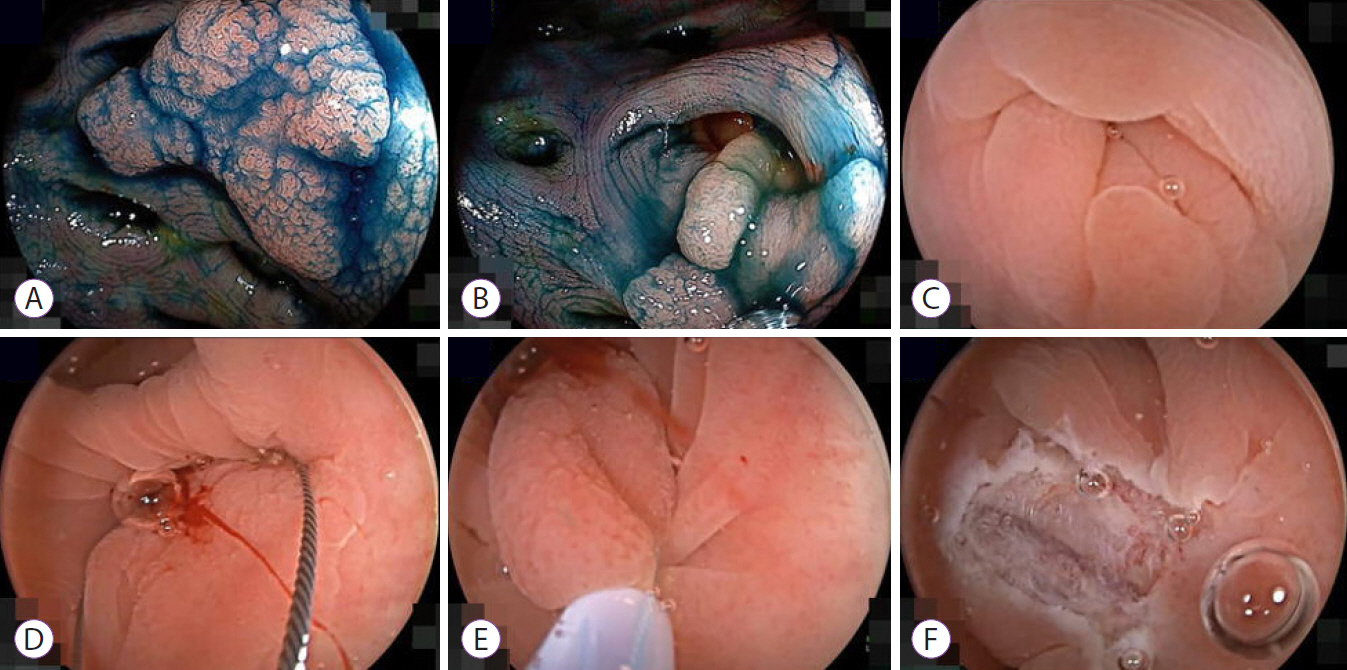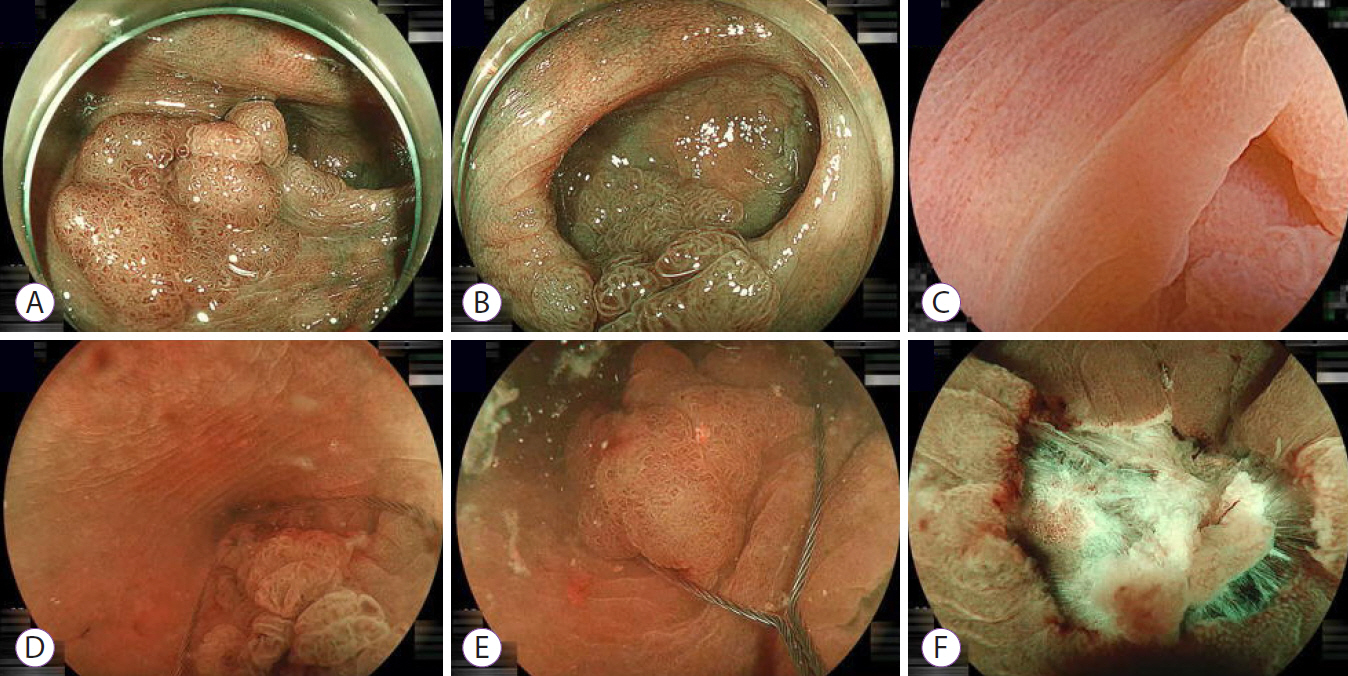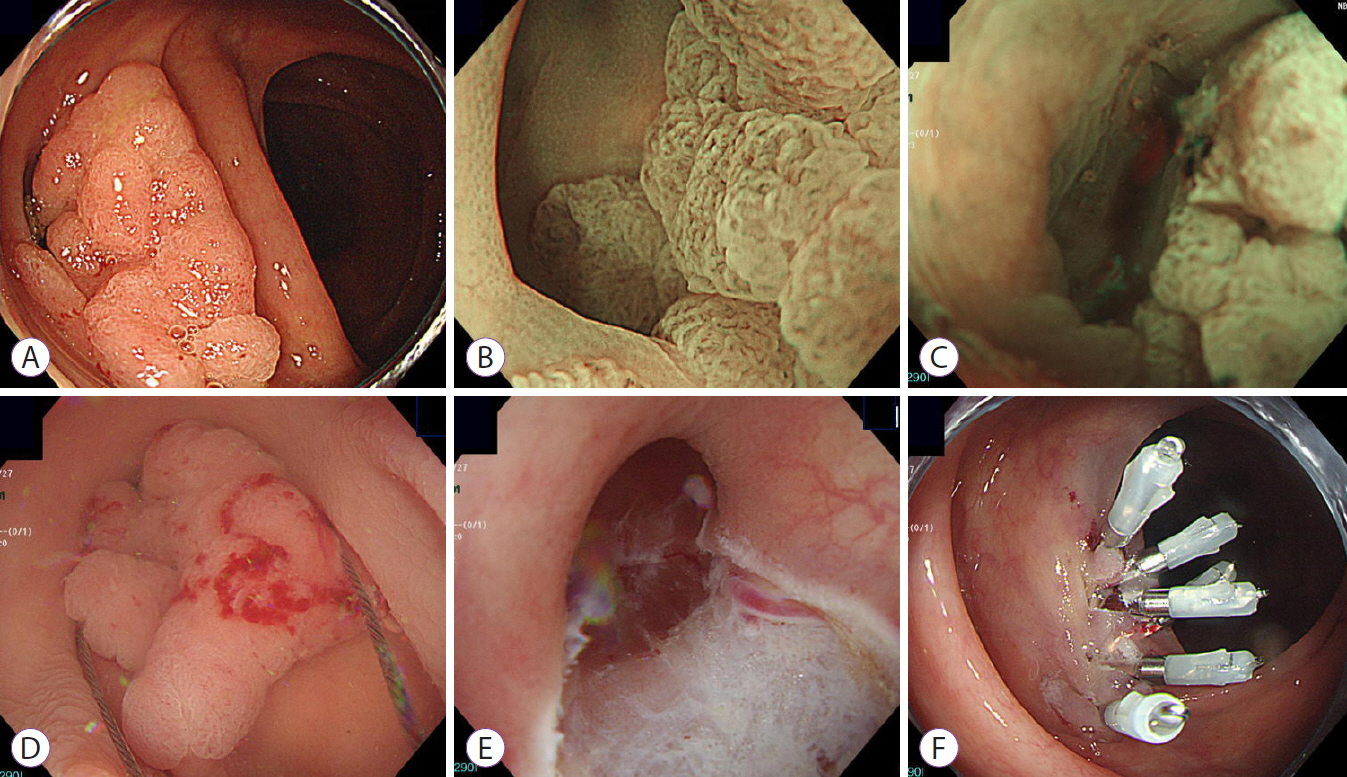Clin Endosc.
2021 May;54(3):436-440. 10.5946/ce.2020.168.
Underwater Endoscopic Mucosal Resection without Submucosal Injection Facilitates En bloc Resection of Colon Adenomas Extending into a Diverticulum
- Affiliations
-
- 1Division of Gastroenterology, Department of Medicine, Jichi Medical University, Shimotsuke, Japan
- 2Department of Gastroenterology, ShinOyama City Hospital, Oyama, Japan
- 3Department of Surgery, Jichi Medical University, Shimotsuke, Japan
- KMID: 2516326
- DOI: http://doi.org/10.5946/ce.2020.168
Abstract
- Superficial colonic neoplasms sometimes extend into a diverticulum. Conventional endoscopic mucosal resection of these lesions is considered challenging because colonic diverticula do not have a muscularis propria and are deeply inverted. Even if the solution is carefully injected below the mucosa at the bottom of the diverticulum, the mucosa is rarely elevated from the diverticular orifice, and it is usually just narrowed. Although endoscopic submucosal dissection or full-thickness resection with an over-the-scope clip device enables the complete resection of these lesions, it is still challenging, time consuming and expensive. Underwater endoscopic mucosal resection without submucosal injection (UEMR) is an innovative technique enabling en bloc resection of superficial colon lesions. We report three patients with colon adenomas extending into a diverticulum treated with successful UEMR. UEMR enabled rapid and safe en bloc resection of colon lesions extending into a diverticulum.
Figure
Reference
-
1. Ferlay J, Soerjomataram I, Ervik M, et al. GLOBOCAN 2012 v1.0, cancer incidence and mortality worldwide: IARC CancerBase No. 11 [Internet]. Lyon: International Agency for Research on Cancer;c2013. [updated 2017 Aug 23]. Available from: https://publications.iarc.fr/Databases/Iarc-Cancerbases/GLOBOCAN-2012-Estimated-Cancer-Incidence-Mortality-And-Prevalence-Worldwide-In-2012-V1.0-2012.2. Winawer SJ, Zauber AG, Ho MN, et al. Prevention of colorectal cancer by colonoscopic polypectomy. The National Polyp Study Workgroup. N Engl J Med. 1993; 329:1977–1981.3. Zauber AG, Winawer SJ, O’Brien MJ, et al. Colonoscopic polypectomy and long-term prevention of colorectal-cancer deaths. N Engl J Med. 2012; 366:687–696.
Article4. Imai K, Hotta K, Ono H. Unusual colonic mucosal cancer extending into a diverticulum. Dig Endosc. 2014; 26:752.
Article5. Binmoeller KF, Weilert F, Shah J, Bhat Y, Kane S. “Underwater” EMR without submucosal injection for large sessile colorectal polyps (with video). Gastrointest Endosc. 2012; 75:1086–1091.
Article6. Yamashina T, Uedo N, Akasaka T, et al. Comparison of underwater vs conventional endoscopic mucosal resection of intermediate-size colorectal polyps. Gastroenterology. 2019; 157:451–461.e2.
Article7. Shiotsuki K, Imai K, Hotta K, Ito S, Kishida Y, Ono H. Underwater endoscopic mucosal resection for complete R0 removal of an adenoma extending deep into a colonic diverticulum. Endoscopy. 2020; 52:E374–E375.
Article8. Lee RF, Nomura T, Hayashi Y, Okada M, Yamamoto H. En bloc removal of a colonic polyp using progressive polyp contraction with underwater endoscopic mucosal resection: the PP-CUE technique. Endoscopy. 2020; 52:E434–E436.
Article9. Ponugoti PL, Rex DK. Perforation during underwater EMR. Gastrointest Endosc. 2016; 84:543–544.
Article10. Kawamura T, Sakai H, Ogawa T, et al. Feasibility of underwater endoscopic mucosal resection for colorectal lesions: a single center study in Japan. Gastroenterology Res. 2018; 11:274–279.
Article11. Jimenez-Garcia VA, Yamada M, Ikematsu H, et al. Endoscopic submucosal dissection in management of colorectal tumors near or involving a diverticulum: a retrospective case series. Endosc Int Open. 2019; 7:E664–E671.
Article12. Shakhatreh MH, Hair C, Shaib YH, Green LK. Removal of a colonic polyp in a diverticulum: a novel use of the over-the-scope clip device. Gastrointest Endosc. 2015; 81:756.
Article13. Shichijo S, Yamasaki Y, Takeuchi Y. Case of colonic adenoma involving a diverticulum resected by a traction-assisted endoscopic submucosal dissection technique. Dig Endosc. 2017; 29:729–730.
Article14. Kato M, Uraoka T, Wada M, et al. Laterally spreading tumor involving a colon diverticulum successfully resected by endoscopic submucosal dissection. Gastrointest Endosc. 2016; 84:191–192.
Article15. Albouys J, Geyl S, Charissoux A, et al. Counter-traction using clips and rubber banding for endoscopic submucosal dissection of a laterally spreading tumor involving a diverticulum in the colon. Endoscopy. 2019; 51:E295–E296.
Article
- Full Text Links
- Actions
-
Cited
- CITED
-
- Close
- Share
- Similar articles
-
- Endoscopic Treatment for Superficial Nonampullary Duodenal Tumors
- Comparison of Endoscopic Submucosal Dissection With Endoscopic Mucosal Resection After Circumferential Precutting to Treat Gastric Adenomas ≤15 mm
- Endoscopic Submucosal Dissection for Gastric Tumors: Complete Resection Rate, Resection Time and Complications in Comparison with Endoscopic Mucosal Resection after Circumferential Mucosal Incision with a Needle Knife
- The Usefulness of Endoscopic Subtumoral Dissection for En-bloc Resection of Upper Gastrointestinal Submucosal Tumor
- Tips and Tricks for Better Endoscopic Treatment of Colorectal Tumors: Usefulness of Cap and Band in Colorectal Endoscopic Mucosal Resection




